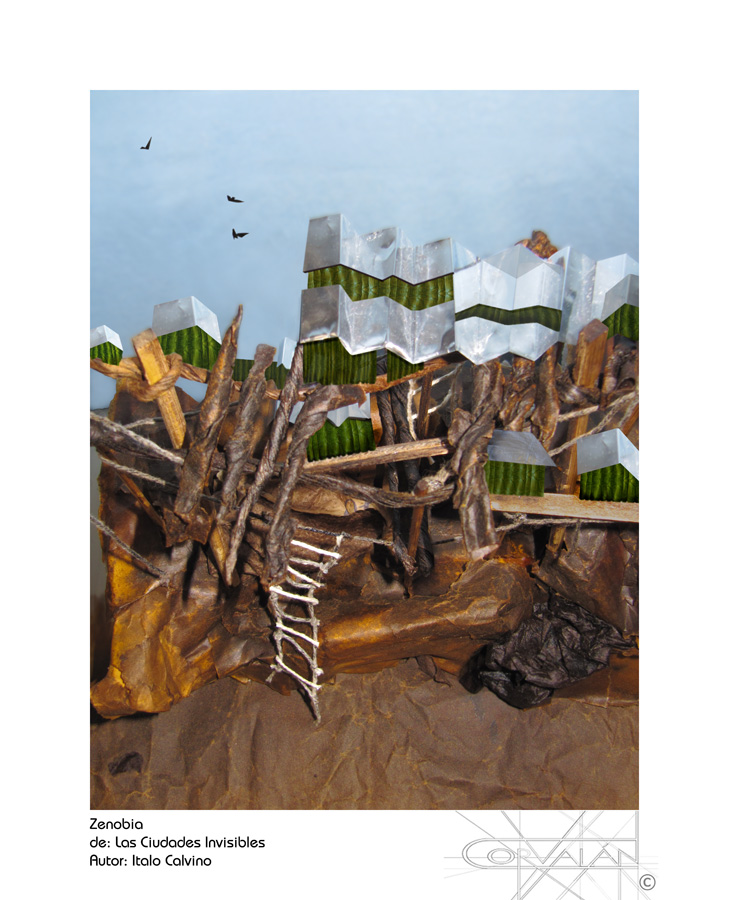ZENOBIA
Se ha demorado un poco poder subir esta foto ya que no fue sencillo... Antes de fotografiarla, he debido construirla.
Ilustración fotográfica inspirada por: ZENOBIA
del libro: 'Las ciudades invisibles'
Capítulo II pag. 19
Autor: Italo Calvino
LAS CIUDADES SUTILES. 2
Ahora diré de la ciudad de Zenobia que tiene esto de admirable: aunque
situada en terreno seco, se levanta sobre altísimos pilotes, y las casas son de bambú y de zinc, con muchas galerías y balcones, situadas a distinta altura, sobre zancos que se superponen unos a otros, unidas por escalas de cuerda y veredas suspendidas, coronadas por miradores cubiertos de techos cónicos, cubas de depósitos de agua, veletas, de los que sobresalen roldanas, sedales y grúas.
No se recuerda qué necesidad u orden o deseo impulsó a los fundadores de Zenobia a dar esta forma a su ciudad, y por eso no se sabe si quedaron satisfechos con la ciudad tal como hoy la vemos, crecida quizá por superposiciones sucesivas del primero y por siempre indescifrable diseño. Pero lo cierto es que si a quien vive en Zenobia se le pide que describa como vería feliz la vida, es siempre una ciudad como Zenobia la que imagina, con sus pilotes y sus escalas colgantes, una Zenobia quizá
totalmente distinta, flameante de estandartes y de cintas , pero obtenida siempre combinando elementos de aquel primer modelo.
Dicho esto, es inútil decidir si ha de clasificarse a Zenobia entre las ciudades felices o entre las infelices. No tiene sentido dividir las ciudades en estas dos especies, sino en otras dos: las que a través de los años y las mutaciones siguen dando su forma a los deseos y aquellas en las que los deseos o bien logran borrar la ciudad o son borrados por ella.
*-*
THIN CITIES 2
Now I shall tell of the city of Zenobia, which is wonderful in this fashion: though set on dry terrain it stands on high pilings, and the houses are of bamboo and zinc, many platforms and balconies placed on stilts at
various heights, crossing one another, linked by ladders and hanging sidewalks, surmounted by cone- roofed belvederes, barrels storing water, weather-vanes, jutting pulleys, and fish poles, and cranes.
No one remembers what need or command or desire drove Zenobia's founders to give their city this form, and so there is no telling whether it was satisfied by the city as we see it today, which has perhaps grown through successive superimpositions from the first, now undecipherable plan. But what is certain is that if you ask an inhabitant of Zenobia to describe his vision of a happy life, it is always a city like Zenobia that he imagines, with its pilings and its suspended stairways, a Zenobia perhaps quite different, a-flutter with banners and ribbons, but always derived by combining elements of that first model. This said, it is pointless trying to decide whether Zenobia is to be classified among happy cities or among
the unhappy. It makes no sense to divide cities into these two species, but rather into another two: those that through the years and the changes continue to give their form to desires, and those in which desires either
erase the city or are erased by it.










isabel jara 22/09/2013 14:19
Una imagen muy interesante, me encanta!!!!************JOKIST 19/09/2013 20:26
° ° ° PERFECT ° ° °LG Ingrid und Hans
Adele D. Oliver 18/09/2013 19:49
what a fabulous way to "reconstract" this city of legends, so inspired, so creative and artistic ... your series is one of a kind, dear Silvia !!!hugs, Adele